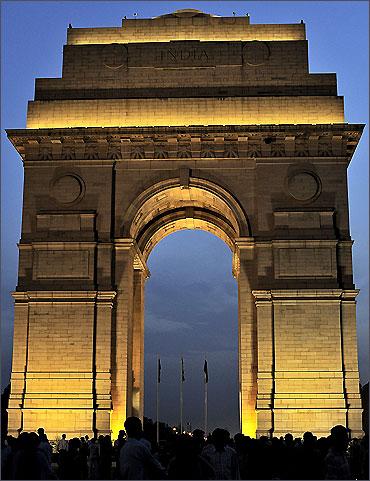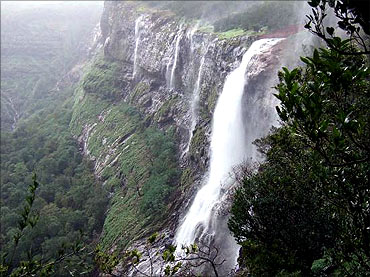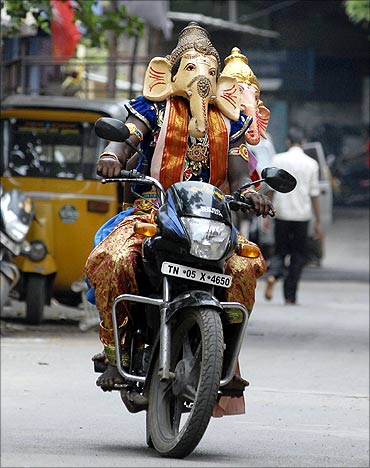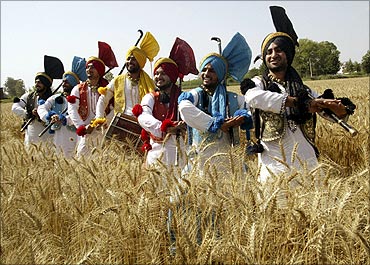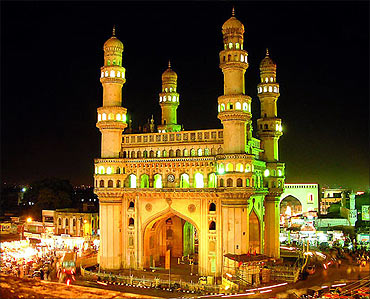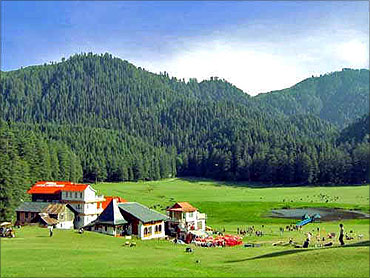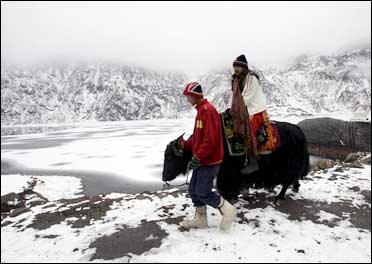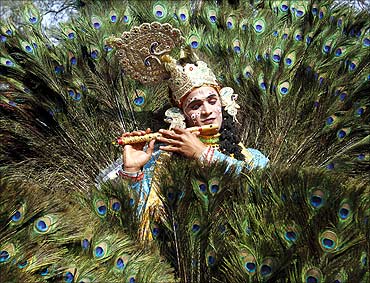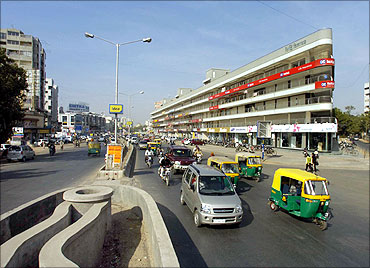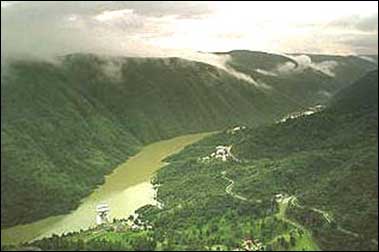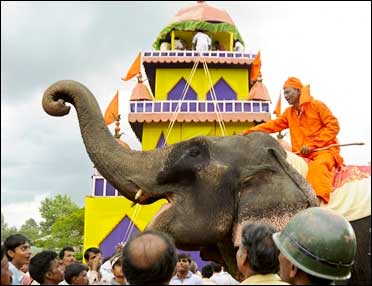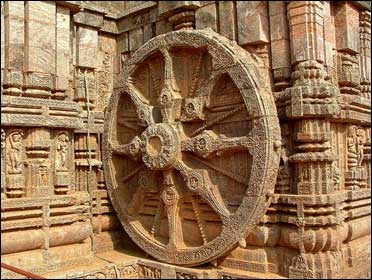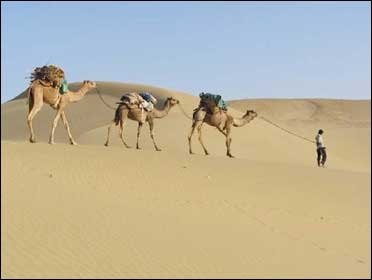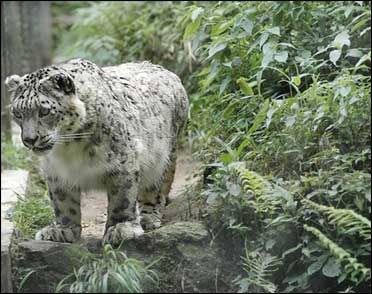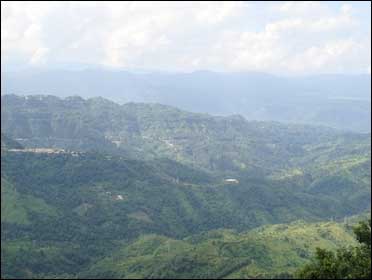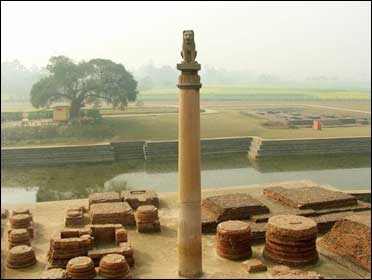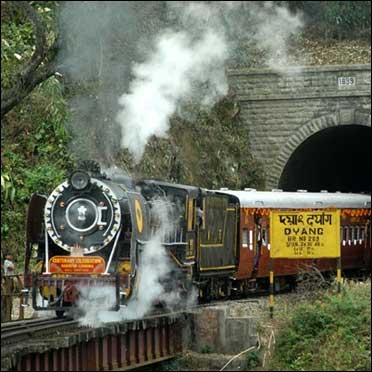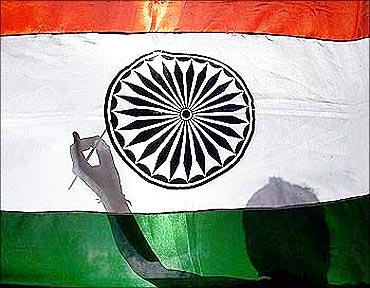 | « Back to article | Print this article |
Financial inclusion: India's top states; Gujarat lags
Financial inclusion is the delivery of banking services at an affordable cost to the vast sections of the poor, the disadvantaged and the low-income groups.
Easy access to public goods and services, especially banking services, is the need of the hour for India.
In India, the focus of the financial inclusion at present is confined to ensuring a bare minimum access to a savings bank account without frills.
The Reserve Bank of India has been talking about widening financial inclusion as one of the objectives in granting licences to new private sector banks which is being mulled. There is also a correlation between social development levels and financial inclusion.
The RBI recently came up with a State-wise Index of Financial Inclusion and the results were rather surprising.
While Kerala topped the index, followed closely by Maharashtra, Gujarat lagged far behind.
In this survey, RBI considered three basic dimensions of an inclusive financial system -- banking penetration, availability of the banking services and usage of the banking system.
The main reasons for selecting these dimensions are data availability and recent development in the literature.
In the group of 23 states for which a 3-dimensional IFI (Index of Financial Inclusion) has been estimated by using data on three dimensions of financial inclusion, Kerala leads with the highest value of IFI followed by Maharashtra and Karnataka.
In fact, all-India average IFI also falls under this category. All other states have a low IFI values, ranging between 0.0 and 0.3.
Click NEXT to check out which Indian states have done the best in terms of financial inclusion and to help improve the lives of the poor. . .
Financial inclusion: India's top states; Gujarat lags
RANK 1: Kerala
IFI score: 0.54
Kerala's gross domestic product per capita stands at Rs 39,815.
Its population is 34,403,000.
Kerala has the highest human development index in India.
Economy is dependent on remittances.
Agriculture, marine products and the service industry dominate the Kerala economy.
Tourism is another revenue earner for the state.
Click NEXT to read further. . .
Financial inclusion: India's top states; Gujarat lags
RANK 2: Maharashtra
IFI score: 0.53
Maharashtra's gross state domestic product is Rs 43,475. Its population is 111,645,000.
Maharashtra is India's leading industrial state contributing 15 per cent of national industrial output and over 40 per cent of India's national revenue.
Major industries in Maharashtra include chemical and allied products, electrical and non-electrical machinery, textiles, petroleum and allied products.
Other important industries include metal products, wine, jewellery, pharmaceuticals, engineering goods, machine tools, steel and iron castings and plastic wares.
Food crops include mangoes, grapes, bananas, oranges, wheat, rice, jowar, bajra, and pulses. Cash crops include groundnut, cotton, sugarcane, turmeric, and tobacco.
Maharashtra is one of India's largest exporters of software.
Click NEXT to read further. . .
Financial inclusion: India's top states; Gujarat lags
RANK 3: Karnataka
IFI score: 0.53
Karnataka's GDP per capita stands at Rs 32,411. Its population is 59,013,000.
Nearly 56 per cent of the workforce in Karnataka is engaged in agriculture and related activities.
Karnataka is the manufacturing hub for some of the largest public sector industries in India, including Hindustan Aeronautics Limited, National Aerospace Laboratories, Bharat Heavy Electricals Limited, Indian Telephone Industries, Bharat Earth Movers Limited and Hindustan Machine Tools, which are based in Bangalore.
Karnataka leads the nation in biotechnology. It is home to India's largest biocluster, with 158 of the country's 320 biotechnology firms being based here.
A majority of the Rs 3,500-crore (Rs 35-billion) silk industry in India is headquartered in Karnataka.
Click NEXT to read further. . .
Financial inclusion: India's top states; Gujarat lags
RANK 4: Tamil Nadu
IFI score: 0.48
Tamil Nadu's GDP per capita stands at Rs 34,417. Its population is 67,161,000.
Services contributes to 45 per cent of the economic activity in the state, followed by manufacturing at 34 per cent and agriculture at 21 per cent.
Tamil Nadu has a network of about 113 industrial parks. It is one of the highly industrialised states in India.
Many heavy engineering and manufacturing companies are located in and around the suburbs of Chennai and Tiruchirappalli.
Tamil Nadu has seen major investments in the automobile industry.
Click NEXT to read further. . .
Financial inclusion: India's top states; Gujarat lags
RANK 5: Punjab
IFI score: 0.45
Punjab's GDP per capita stands at Rs 38,859. Its population is 27,475,000.
Punjab has one of the best infrastructure in all of India. Punjab is called the 'Granary of India' or 'India's bread-basket'.
In worldwide terms, Punjab produces 2 per cent of the world's cotton, 2 per cent of its wheat and 1 per cent of the world's rice.
Besides agriculture other major industries include manufacture of scientific instruments, electrical goods, machine tools, textiles, tourism, sewing machines, sports goods, starch, fertilisers, bicycles, and the processing of pine oil and sugar.
Click NEXT to read further. . .
Financial inclusion: India's top states; Gujarat lags
RANK 6: Andhra Pradesh
IFI score: 0.41
Andhra Pradesh's GDP per capita stands at Rs 31,697. Its population is 84,227,000.
Agriculture has been the chief source of income for the state's economy.
The service sector of the state accounts for 43% of the gross state domestic product and employs 20 per cent of the work force.
Andhra Pradesh ranks second in India in terms of mineral wealth.
The state is famous as hub for both information technology and biotechnology.
Click NEXT to read further. . .
Financial inclusion: India's top states; Gujarat lags
RANK 7: Himachal Pradesh
IFI score: 0.33
Himachal Pradesh's GDP per capita stands at Rs 40,515. It has a population of 6,751,000.
Agriculture contributes over 45 per cent to the net state domestic product. It is the main source of income and employment in Himachal.
Himachal has a rich heritage of handicrafts.
These include woolen and pashmina shawls, carpets, silver and metal ware, embroidered chappals, grass shoes, Kangra and Gompa style paintings, wood work, horse-hair bangles, wooden and metal utensils and various other house hold items.
Himachal is extremely rich in hydro electric resources.
Click on NEXT to read more...
Financial inclusion: India's top states; Gujarat lags
RANK 8: Sikkim
IFI score: 0.32
Sikkim's GDP per capita stands at Rs 29,506. Its population is 608,000.
This is the least populous state in India and the second-smallest state after Goa.
Sikkim has a booming economy dependent on agriculture and tourism, and has the only open border between India and China for trade.
The state is rich in natural resources and has a huge potential for hydel power.
It is an ideal destination for industries to invest in. The state plans to expand agro-based industries, horticulture and floriculture, forest based industries, animal husbandry and dairy products, tourism and information technology sectors.
Sikkim is also a popular tourist destination.
Click NEXT to read further. . .
Financial inclusion: India's top states; Gujarat lags
RANK 9: Haryana
IFI score: 0.32
Haryana's GDP per capita stands at Rs 48,456. It has a population of 25,163,000.
The economy of Haryana relies on manufacturing, business process outsourcing, agriculture and retail.
Haryana is also considered one of the most industrilised states in India with many SEZs.
The state has a developed banking system with over 4,500 bank branches. The two financial hubs of Haryana, Gurgaon and Faridabad lie on the south west of the state.
Click NEXT to read further. . .
Financial inclusion: India's top states; Gujarat lags
RANK 10: West Bengal
IFI score: 0.28
West Bengal's GDP per capita stands at Rs 27,062. Its population is 88,948,000.
West Bengal's growth was faster than India as a whole in per capita terms until 2004-05, after which its expansion has fallen. The per capita income of West Bengal is now lower than the national average.
Agriculture and service sector contribute to the state's economic growth.
West Bengal has had the largest number of and the most rapid growth in small-scale and cottage industries.
Rice is considered to be the principal food crop of West Bengal.
Agriculture is the main source of income for about 70 per cent of the population.
Jute and rice are the principal crops grown in the state, along with tea, maize, tobacco and sugarcane.
Click NEXT to read further. . .
Financial inclusion: India's top states; Gujarat lags
RANK 11: Gujarat
IFI score: 0.26
Gujarat's GDP per capita stands at Rs 40,004. It has a population of 58,500,000.
Gujarat has some of the largest businesses in India.
Major agricultural produce of the state include cotton, groundnuts (peanuts), dates, sugar cane, milk and milk products.
Industrial products include cement and petrol.
Reliance Industries Limited founded by Dhirubhai Ambani, operates the oil refinery at Jamnagar, which is the world's largest grass-roots refineries.
The world's largest shipbreaking yard is in Gujarat near Bhavnagar at Alang.
Over 20 per cent of the S&P CNX 500 conglomerates have corporate offices in Gujarat.
Click NEXT to read further. . .
Financial inclusion: India's top states; Gujarat lags
RANK 12: Uttar Pradesh
IFI score: 0.24
Uttar Pradesh's GDP per capita stands at Rs 15,055. Its population is 198,455,000.
The major economic activity in the state is agriculture.
Kanpur is the largest shoe-manufacturing centre in the country with strong leather , engineering, chemical and other booming sector industries.
The economy also benefits from the state's thriving tourism industry.
Click on NEXT to read more. . .
Financial inclusion: India's top states; Gujarat lags
RANK 13: Meghalaya
IFI score: 0.21
Meghalays's GDP per capita stands at Rs 25,349. Its population is 2,601,000.
Meghalaya has an agrarian economy. It's service sector is dominated by real estate and insurance companies.
The important crops of the state are potato, rice, maize, pineapple and banana.
Meghalaya has a rich base of natural resources. These include minerals such as coal, limestone, sillimanite, Kaolin and granite among others. Meghalaya also has a large forest cover, rich biodiversity and numerous water bodies.
During the last few years, Meghalaya has developed into a growing destination for both domestic and international tourists.
The Planning Commission has fixed Meghalaya's annual plan for 2011-12 at Rs 2,727 crore (Rs 27.22 billon), an increase of 22 per cent over the previous year's fund allocation of Rs 2,230 crore (Rs 22.3 billion).
Click on NEXT to read more...
Financial inclusion: India's top states; Gujarat lags
RANK 14: Tripura
IFI: 0.20
Tripura's GDP per capita stands at Rs 24,034. Its population is 3,588,000.
Tripura's economy is mainly dependent on agriculture.
Though Tripura has a huge potential, the industry sector is underdeveloped.
High poverty and low per capita income have been the biggest drawbacks of Tripura.
Lack of irrigation facilities and infrastructure has aggravated the state's economic woes.
Click NEXT to read further. . .
Financial inclusion: India's top states; Gujarat lags
RANK 15: Orissa
IFI score: 0.20
Orissa's GDP per capita stands at Rs 22,287. Its population is 40,512,000.
Orissa is one of the poorest states in India.
It has abundant natural resources and a large coastline. It contains a fifth of India's coal, a quarter of its iron ore, a third of its bauxite reserves and most of the chromite.
Recently the number of companies who have signed memoranda of understanding to set up steel plants in the state has gone up to 50, including Posco of South Korea which has agreed to construct a mammoth $12 billion steel plant near Paradip port.
The Central government has agreed to accord special economic zone status to eight sites in Orissa.
Click NEXT to read further. . .
Financial inclusion: India's top states; Gujarat lags
RANK 16: Rajasthan
IFI score: 0.19
Rajasthan's GDP per capita stands at Rs 22,350. Its population is 67,121,000.
Rajasthan's economy is primarily agricultural and pastoral. Tourism too contributes a major chunk to the economy.
The main industries are mineral based, agriculture based, and textiles. Known as a shopper's paradise, Rajasthan is famous for textiles, semi-precious stones and handicrafts.
Click NEXT to read further. . .
Financial inclusion: India's top states; Gujarat lags
RANK 17: Arunachal Pradesh
IFI score: 0.17
Arunachal Pradesh's GDP per capita stands at Rs 25,110. Its population is 1,231,000.
Arunachal Pradesh clocked the highest economic growth rate in the country of 22.43 per cent in 2009-10.
Agriculture drives the economy. Rice, maize, millet, wheat, pulses, sugarcane, ginger, and oilseeds are the main crops grown in the state.
Arunachal is also ideal for horticulture and fruit orchards. Its major industries are rice mills, fruit preservation units, handloom and handicrafts.
Arunachal Pradesh accounts for a large percentage of India's untapped hydroelectric power production potential.
The tourism sector is yet to meet its full potential. The restricted/protected area permit restricts the number of foreign tourists.
Click NEXT to read further. . .
Financial inclusion: India's top states; Gujarat lags
RANK 18: Mizoram
IFI score: 0.16
Mizoram's GDP per capita stands at Rs 24,337. Its population is 997,000.
Mizoram lags behind economically due to the lack of markets and raw materials.
The state has good potential for economic growth in the areas of agriculture, horticulture, tourism and handicraft. Around 70 per cent of the population is engaged in agriculture.
The lack of adequate transport infrastructure has hindered the economic growth and development.
Mizoram registered a gross state domestic product growth of 13.95 per cent in 2009-10.
Cottage industry and other small-scale industries play an important role in the economy.
Click NEXT to read further. . .
Financial inclusion: India's top states; Gujarat lags
RANK 19: Madhya Pradesh
IFI score: 0.16
Madhya Pradesh's GDP per capita stands at Rs 16,963. Its population is 71,439,000.
About 70% of the total work force of the state depends directly or indirectly on agriculture.
Mines and industries play important roles in economic development of the state.
There are many flourishing textile mills in the state and artificial silk manufacturing plants located at Ujjain, Nagda, Indore and Gwalior.
The Nepa Mills produces newsprint for the country. Diesel engines are manufactured at Indore and attractive pottery and carpets are produced at Gwalior.
A sizeable population in the villages makes traditional crafts such as chanderi sarees, leather and clay toys.
Click NEXT to read further. . .
Financial inclusion: India's top states; Gujarat lags
RANK 20: Bihar
IFI score: 0.15
Bihar's GDP per capita stands at Rs 11,416. Its population is 96,847,000.
The economy of Bihar is largely service oriented, but it also has a significant agricultural base.
The state also has a small industrial sector.
Bihar has significant levels of production of mango, guava, litchi, pineapple, brinjal, cauliflower, bhindi, and cabbage.
Click NEXT to read further. . .
Financial inclusion: India's top states; Gujarat lags
RANK 21: Assam
IFI score: 0.13
Assam's GDP per capita stands at Rs 18,877. Its population is 30,317,000.
Apart from tea and petroleum refineries, Assam has few industries of significance.
Assam is a major producer of crude oil and it accounts for about 15 per cent of India's crude output.
Although having a poor overall industrial performance, several other industries have nevertheless been started.
Moreover, there are other industries such as jute mill, textile and yarn mills, silk mill, etc.
Click on NEXT to read more...
Financial inclusion: India's top states; Gujarat lags
RANK 22: Nagaland
IFI score: 0.05
Nagaland's GDP per capita stands at Rs 18,490. Its population is 2,232,000.
Agriculture is the most important economic activity in Nagaland, with more than 90% of the population employed in the fields.
Crops include rice, corn, millets, pulses, tobacco, oilseeds, sugarcane, potatoes, and threads. Forestry is also an important source of income.
Cottage industries such as weaving, woodwork, and pottery are also an important source of revenue.
Tourism is important, but largely limited due to insurgency since the last five decades.
Click NEXT to read further. . .
Financial inclusion: India's top states; Gujarat lags
RANK 23: Manipur
IFI score: 0.01
Manipur's GDP per capita stands at Rs 18,347. Its population is 2,430,000.
Manipur economy is based on agriculture, forest products, industries, mining, and tourism sectors.
The agrarian economy has various kinds of crops like rice, maize, pulses, and wheat.
The Manipur economy gets its revenue from forest products and mining sector. With a large forest cover, these products are manufactured are even exported to foreign countries.
Click NEXT to read further. . .
Financial inclusion: India's top states; Gujarat lags
It should be mentioned here that a nationwide programme on financial inclusion, 'Swabhimaan' was launched in February, 2011 by the government.
The programme is focused on bringing the deprived sections of the society in banking network to ensure that the benefits of economic growth reach everyone at all levels.
This campaign promises to bring basic banking services to 73,000 unbanked villages with a population of 2,000 and above by March, 2012 and at least 5 crore (50 million) new accounts will be opened.
The movement will facilitate opening of banks accounts, provide need-based credit, remittance facilities and help to promote financial literacy in rural India.
The programme will increase the demand for credit among the millions of small and marginal farmers and rural artisans who will benefit by having access to banking facilities.
Source: PIB
